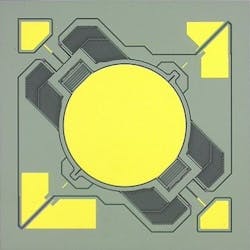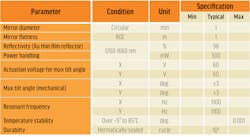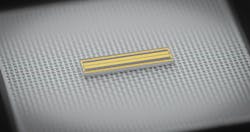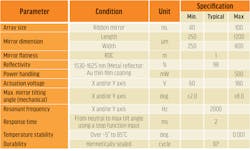Optical micro electromechanical systems (MEMS) mirrors and mirror arrays have played an important role in the explosive growth of fiber-optic communications. Millions of the chips have been supplied to the global market just since 2018. MEMS mirrors and mirror arrays enable smaller form factors, higher reliability, and ultra-low power consumption compared to the conventional technologies such as electrical motor-driven products. As a result, the market demand has increased each year for MEMS-based variable optical attenuators (VOAs), tunable optical filters (TOFs), optical channel monitors (OCMs), and 1xN switches.
MEMS as ROADM elements
Modern colorless, directionless, contentionless, and flexible grid (CDC-F) ROADM networks have gained wide industry acceptance due to their flexibility, simplified operations, and improved efficiency. The add/drop block is the engine of the CDC-F ROADM node and is implemented using multi-cast switch (MCS) modules and NxM switch modules.
The MCS module consists of an array of splitters, couplers, and 1xN switches. An array of 1xN switches and splitters establishes the drop function, and an array of 1xN switches and couplers form the drop function. The MEMS 2D tilting mirror chip in Figure 1 can be used for 1xN switches. These MEMS switches can be configured as either 1x8 or 1x16 with minimal crosstalk between the channels. The common specifications of MEMS 2D tilting mirrors are shown in Table 1.
The insertion loss introduced by the array of splitters and couplers in the MCS architecture can be mitigated by an EDFA array. However, the total power of the channel increases proportionally with the overall bandwidth of the coherent signal channel. For a typical 8x16 MCS, EDFA arrays associated with the MCS cannot meet the power requirement for a 150-GHz channel bandwidth.
Comparing multiple single 1xN 2D MEMS mirror chips as an alternative, a single monolithic MEMS mirror array chip offers advantages of higher reliability, lower insertion loss, lower packaging cost, and smaller form factor that enables the smaller NxM wavelength-selective switch (WSS) module to fit into space-limited applications. The high-fill-factor MEMS mirror array could be configured as a 1D linear mirror array or multiple 1D linear arrays. Each mirror size ranges from sub-millimeter to millimeters. Each mirror is independently actuated by electrostatic actuators. The tilting of each mirror could be 1D or 2D. The gold thin-film mirror reflector provides low insertion loss for wavelengths around 1550 nm. The higher than 2 kHz of resonant frequency of each mirror offers good mechanical strength to pass the shock and vibration requirements of Telcordia GR-1221-Core.
The chip is made of single crystal silicon, which has excellent mechanical performance, achieving high reliability rated at billions of switching cycles. Figure 2 shows the high-fill-factor MEMS mirror array chip for an NxM WSS. The major specifications of the MEMS mirror array chip are shown in Table 2.
The benefits of this approach
The high-fill-factor MEMS mirror array chip as the NxM add/drop block tightly integrates with the WSS module to form a single NxM WSS module. Without the high-loss power splitters and couplers, a MEMS mirror array based NxM add/drop block can achieve less than 8-dB insertion loss.
When a MEMS mirror array is integrated with a liquid crystal on silicon (LCoS) based WSS, with no EDFA arrays in the add/drop path, there are no limitations on channel bandwidth or power as would be the case with an MCS configuration. The result is that a contentionless NxM WSS can seamlessly support wider bandwidth channels of any total optical power.
Reference
Randy Eisenach, "Understanding CDC-F ROADM Add/Drop Architectures," Oct. 15, 2021.
Dr. Tiansheng Zhou is the founder and chief technology officer of Preciseley Microtechnology Corp. (PMC). He founded the company in 2006, initially providing custom optical MEMS chip design and product development services for optical communications companies, then later transitioning PMC to become a global supplier of optical MEMS chips serving the optical communications industry. Dr. Zhou has more than 25 years of advanced research and development experience in optical MEMS and nanotechnology. His expertise includes the design and manufacturing of MEMS devices, lasers, and photonics equipment.
Dr. Tiansheng Zhou | Founder and Chief Technology Officer, Preciseley Microtechnology Corp
Dr. Tiansheng Zhou is the founder and chief technology officer of Preciseley Microtechnology Corp. (PMC). He founded the company in 2006, initially providing custom optic MEMS chip design and product development services for optical communications companies, then later transitioning PMC to become a global supplier of optical MEMS chips serving the optical communications industry. Dr. Zhou has more than twenty-five years of advanced research and development experience in optic MEMS and nanotechnology. His expertise includes the design and manufacturing of MEMS devices, lasers, and photonics equipment.




